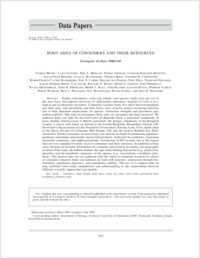Body sizes of consumers and their resources
- Brose, Ulrich Department of Biology, Technical University of Darmstadt, Germany
- Cushing, Lara Pacific Ecoinformatics and Computational Ecology Lab, Rocky Mountain Biological Laboratory, Gothic, Colorado, USA
- Berlow, Eric L. White Mountain Research Station, University of California, San Diego, USA
- Jonsson, Tomas Department of Natural Science, University of Skövde, Sweden
- Banasek-Richter, Carolin Department of Biology, Technical University of Darmstadt, Germany
- Bersier, Louis-Félix Department of Biology, Unit of Ecology and Evolution, Switzerland
- Blanchard, Julia L. The Centre for Environment, Fisheries and Aquaculture Science, Suffolk, UK
- Brey, Thomas Alfred Wegener Institute for Polar and Marine Research, Bremerhaven, Germany
- Carpenter, Stephen R. Center for Limnology, University of Wisconsin, Madison, USA
- Cattin Blandenier, Marie-France Zoological Institute, Neuchâtel, Switzerland
- Cohen, Joel E. Laboratory of Populations, Rockefeller and Columbia Universities, New York, USA
- Dawah, Hassan Ali King Khalid University, College of Science, Department of Biology, Abha, Saudi Arabia
- Dell, Tony Department of Zoology and Tropical Ecology, James Cook University, Townsville, Australia
- Edwards, Francois School of Geography, Earth and Environmental Sciences, University of Birmingham, UK
- Harper-Smith, Sarah Department of Biology, Seattle Pacific University, USA
- Jacob, Ute Alfred Wegener Institute for Polar and Marine Research, Bremerhaven, Germany
- Knapp, Roland A. Sierra Nevada Aquatic Research Laboratory, University of California, Crowley Lake, USA
- Ledger, Mark E. School of Geography, Earth and Environmental Sciences, University of Birmingham, UK
- Memmott, Jane School of Biological Sciences, Bristol, UK
- Mintenbeck, Katja Alfred Wegener Institute for Polar and Marine Research, Bremerhaven, Germany
- Pinnegar, John K. The Centre for Environment, Fisheries and Aquaculture Science, Suffolk, UK
- Rall, Björn C. Department of Biology, Technical University of Darmstadt, Germany
- Rayner, Thomas School of Tropical Biology and Rainforest CRC, James Cook University, Townsville, Australia
- Ruess, Liliane Department of Biology, Technical University of Darmstadt, Germany
- Ulrich, Werner Department of Animal Ecology, Nicolaus Copernicus University, Torun, Poland
- Warren, Philip Department of Animal and Plant Sciences, University of Sheffield, UK
- Williams, Richard J. Pacific Ecoinformatics and Computational Ecology Lab, Rocky Mountain Biological Laboratory, Gothic, Colorado, USA
- Woodward, Guy School of Biological Sciences, Queen Mary University of London, UK
- Yodzis, Peter Department of Zoology, University of Guelph, Canada
- Martinez, Neo D. Pacific Ecoinformatics and Computational Ecology Lab, Rocky Mountain Biological Laboratory, Gothic, Colorado, USA
-
2005
Published in:
- Ecology. - 2005, vol. 86, p. 2545
English
Trophic information—who eats whom—and species' body sizes are two of the most basic descriptions necessary to understand community structure as well as ecological and evolutionary dynamics. Consumer–resource body size ratios between predators and their prey, and parasitoids and their hosts, have recently gained increasing attention due to their important implications for species' interaction strengths and dynamical population stability. This data set documents body sizes of consumers and their resources. We gathered body size data for the food webs of Skipwith Pond, a parasitoid community of grass-feeding chalcid wasps in British grasslands; the pelagic community of the Benguela system, a source web based on broom in the United Kingdom; Broadstone Stream, UK; the Grand Cariçaie marsh at Lake Neuchâtel, Switzerland; Tuesday Lake, USA; alpine lakes in the Sierra Nevada of California; Mill Stream, UK; and the eastern Weddell Sea Shelf, Antarctica. Further consumer–resource body size data are included for planktonic predators, predatory nematodes, parasitoids, marine fish predators, freshwater invertebrates, Australian terrestrial consumers, and aphid parasitoids. Containing 16 807 records, this is the largest data set ever compiled for body sizes of consumers and their resources. In addition to body sizes, the data set includes information on consumer and resource taxonomy, the geographic location of the study, the habitat studied, the type of the feeding interaction (e.g., predacious, parasitic) and the metabolic categories of the species (e.g., invertebrate, ectotherm vertebrate). The present data set was gathered with the intent to stimulate research on effects of consumer–resource body size patterns on food-web structure, interaction-strength distributions, population dynamics, and community stability. The use of a common data set may facilitate cross-study comparisons and understanding of the relationships between different scientific approaches and models.
- Faculty
- Faculté des sciences et de médecine
- Department
- Département de Biologie
- Language
-
- English
- Classification
- Biological sciences
- Other electronic version
- License
-
License undefined
- Identifiers
-
- RERO DOC 12580
- DOI 10.1890/05-0379
- Persistent URL
- https://folia.unifr.ch/unifr/documents/301378
Statistics
Document views: 192
File downloads:
- pdf: 187
